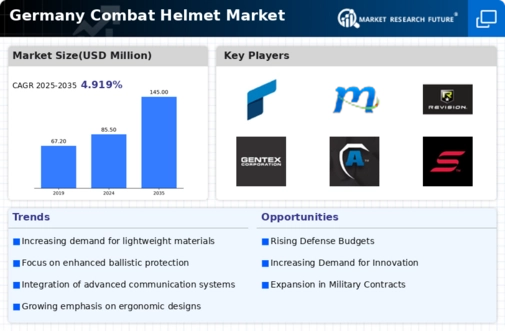Rising Threat Levels
The combat helmet market in Germany is influenced by rising threat levels, both domestically and internationally. The geopolitical landscape has become increasingly complex, with heightened concerns regarding terrorism and regional conflicts. This situation has prompted the German military to prioritize the safety of its personnel, leading to a surge in demand for advanced combat helmets. According to recent assessments, the need for improved protective gear is expected to grow by approximately 15% over the next five years. Consequently, manufacturers in the combat helmet market are focusing on developing helmets that offer enhanced ballistic protection and comfort. This ensures that soldiers are adequately equipped to face evolving threats.
Technological Integration
The integration of advanced technologies into the combat helmet market is a key driver of growth in Germany. Innovations such as augmented reality (AR) and communication systems are being incorporated into helmet designs, enhancing situational awareness for soldiers. This trend is evident in the development of helmets equipped with integrated communication devices, which facilitate real-time information sharing among troops. As the German military seeks to modernize its forces, the demand for technologically advanced helmets is expected to increase significantly. Market analysts project that the segment of helmets featuring integrated technology could account for up to 30% of total sales in the combat helmet market by 2027, reflecting a shift towards multifunctional protective gear.
Increased Defense Spending
Increased defense spending by the government is driving growth in the combat helmet market in Germany. In recent years, the German government has committed to enhancing its military capabilities, which includes investing in advanced personal protective equipment. This trend is reflected in the 2025 defense budget, which allocates approximately €53 billion for military expenditures. As a result, the demand for high-quality combat helmets is likely to rise, as military forces seek to equip personnel with the latest protective gear. This increased funding not only supports the procurement of helmets but also encourages research and development in the combat helmet market, leading to innovations that enhance safety and performance.
Focus on Soldier Well-being
The combat helmet market in Germany is increasingly prioritizing the well-being of soldiers, driving demand for helmets that emphasize comfort and ergonomics. Recognizing that prolonged use of heavy helmets can lead to fatigue and discomfort, manufacturers are investing in lightweight materials and improved designs. This emphasis on soldier well-being is supported by studies indicating that comfortable helmets can enhance performance and reduce the risk of injuries. As a result, the market is witnessing a shift towards helmets that not only provide protection but also ensure that soldiers can operate effectively in various environments. This trend is likely to contribute to a projected growth rate of 10% in the combat helmet market over the next few years.
Increased Collaboration with NATO
The combat helmet market in Germany is benefiting from increased collaboration with NATO forces, which is fostering standardization and interoperability among member nations. As Germany participates in joint military exercises and operations, the need for compatible equipment, including helmets, becomes paramount. This collaboration encourages the adoption of similar standards and technologies across NATO countries, which can lead to bulk procurement and shared research initiatives. Consequently, the combat helmet market is likely to see a rise in demand for helmets that meet NATO specifications, potentially increasing market size by 20% in the coming years. This alignment not only enhances operational efficiency but also drives innovation within the combat helmet market.


















Leave a Comment